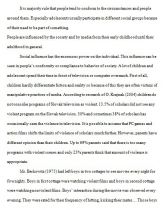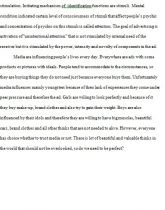Hľadaj
Zobraz:
Univerzity
Kategórie
Rozšírené vyhľadávanie
45 144
projektov
Social influence and media influence
| Prípona .doc |
Typ semestrálna práca |
Stiahnuté 1 x |
| Veľkosť 0,5 MB |
Jazyk anglický |
ID projektu 11701 |
| Posledná úprava 19.12.2018 |
Zobrazené 972 x |
Autor: - |
 Zdieľaj na Facebooku
Zdieľaj na Facebooku |
||
| Detaily projektu | ||
- cena:
40 Kreditov - kvalita:
87,1% -
Stiahni
- Pridaj na porovnanie
- Univerzita:Vysoká škola ekonómie a manažmentu verejnej správy v Bratislave
- Fakulta:-
- Kategória:Humanitné vedy » Psychológia
- Predmet:Psychologická analýza
- Študijný program:-
- Ročník:1. ročník
- Formát:MS Office Word (.doc)
- Rozsah A4:9 strán
It is majority rule that people tend to conform to the circumstances and people around them. Especially adolescents usually participate in different social groups because of their need to be part of something.
People are influenced by the society and by media from their early childhood until their adulthood in general.
Social influence has the enormous power on the individual. This influence can be seen in people’s conformity or compliance to behavior of society. A lot of children and adolescent spend their time in front of television or computer overmuch. First of all, children hardly differentiate fiction and reality so because of this they are often victims of manipulative practices of media. According to research of O. Krajnak (2004) children do not consider programs of Slovak television as violent. 13.5% of scholars did not see any violent program on the Slovak television. 30% and sometimes 38% of scholars has occasionally seen the violence in television. It is possible to assume that PC games and action films shifts the limits of violence of scholars much further. However, parents have different opinion than their children. Up to 69% parents said that there is too many programs with violent scenes and only 23% parents think that amount of violence is appropriate.
People are influenced by the society and by media from their early childhood until their adulthood in general.
Social influence has the enormous power on the individual. This influence can be seen in people’s conformity or compliance to behavior of society. A lot of children and adolescent spend their time in front of television or computer overmuch. First of all, children hardly differentiate fiction and reality so because of this they are often victims of manipulative practices of media. According to research of O. Krajnak (2004) children do not consider programs of Slovak television as violent. 13.5% of scholars did not see any violent program on the Slovak television. 30% and sometimes 38% of scholars has occasionally seen the violence in television. It is possible to assume that PC games and action films shifts the limits of violence of scholars much further. However, parents have different opinion than their children. Up to 69% parents said that there is too many programs with violent scenes and only 23% parents think that amount of violence is appropriate.
Kľúčové slová:
social influence
media influence
anglický jazyk
angličtina
influence
Zdroje:
- Berkowitz, L., & Powers, P.C. (1979). Effects of timing and justification of witnessed aggression on the observers’ punitiveness. Journal of Research in Personality, 13, 71-80.
- Josephson, W.L. (1987). Television violence and children’s aggression: Testing the priming, social script, and disinhibition predictions. Journal of Personality and Social Psychology, 53, 882-890.
- McCabe, M. P., & Ricciardelli, L. A. (2002). Psychometric evaluation of the Body Change Inventory: An assessment instrument for adolescent boys and girls. Eating Behaviors, 3, 45-59.
- Thomsen, S. R., Weber, M. M., & Brown, L. B. (2002). The relationship between reading beauty and fashion magazines and the use of pathogenic dieting methods among adolescent females. Adolescence, 37, 1-18.
- Utter, F., Neumark-Sztainer, D., Wall, M., & Story, M. (2003). Reading magazine articles about dieting and associated weight control behaviors among adolescents.
- Journal of Adolescent Health, 32, 78-82. Vicary, J., Subliminal messages (2008). Retreived May 25, 2008 from Web site: http://www.espconsultancy.co.uk/SubliminalInfluence.html







